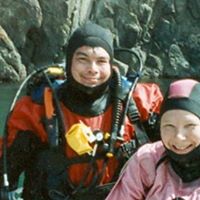Susan E Lundquist
age ~69
from Manistee, MI
- Also known as:
-
- Susan G Lundquist
- Susan E Godwin
- Sue Godwin
Susan Lundquist Phones & Addresses
- Manistee, MI
- Great Barrington, MA
- Saint Paul, MN
- Salem, NH
- Derry, NH
- Methuen, MA
Isbn (Books And Publications)

The Patissier: Recipes And Conversations from Alsace, France
view sourceAuthor
Susan Lundquist
ISBN #
0595365051
Us Patents
-
Process For Modifying The Metal Ion Sorption Capacity Of A Medium
view source -
US Patent:6436294, Aug 20, 2002
-
Filed:Nov 24, 1998
-
Appl. No.:09/199296
-
Inventors:Susan H. Lundquist - White Bear Township MN
-
Assignee:3M Innovative Properties Company - St. Paul MN
-
International Classification:B01D 1504
-
US Classification:210674, 210679, 210682, 210688, 502408, 521 26
-
Abstract:A process for modifying a medium is disclosed that includes treating a medium having a metal ion sorption capacity with a solution that includes: A) an agent capable of forming a complex with metal ions; and B) ions selected from the group consisting of sodium ions, potassium ions, magnesium ions, and combinations thereof, to create a medium having an increased capacity to sorb metal ions relative to the untreated medium.
-
Method For Removing Metal Ions From Solution With Titanate Sorbents
view source -
US Patent:59894342, Nov 23, 1999
-
Filed:Oct 31, 1997
-
Appl. No.:8/960528
-
Inventors:Susan H. Lundquist - White Bear Township MN
Lloyd R. White - Minneapolis MN -
Assignee:3M Innovative Properties Company - St. Paul MN
-
International Classification:B01D 1504
-
US Classification:210679
-
Abstract:A method for removing metal ions from solution comprises the steps of providing titanate particles by spray-drying a solution or slurry comprising sorbent titanates having a particle size up to 20 micrometers, optionally in the presence of polymer free of cellulose functionality as binder, said sorbent being active towards heavy metals from Periodic Table (CAS version) Groups IA, IIA, IB, IIB, IIIB, and VIII, to provide monodisperse, substantially spherical particles in a yield of at least 70 percent of theoretical yield and having a particle size distribution in the range of 1 to 500 micrometers. The particles can be used free flowing in columns or beds, or entrapped in a nonwoven, fibrous web or matrix or a cast porous membrane, to selectively remove metal ions from aqueous or organic liquid.
-
Adsorbent For Metal Ions And Method Of Making And Using
view source -
US Patent:59353805, Aug 10, 1999
-
Filed:Aug 27, 1997
-
Appl. No.:8/918113
-
Inventors:Lloyd R. White - Minneapolis MN
Susan H. Lundquist - White Bear Township MN -
Assignee:3M Innovative Properties Company - St. Paul MI
-
International Classification:B01D 118
-
US Classification:159 481
-
Abstract:A method comprises the step of spray-drying a solution or slurry comprising (alkali metal or ammonium) (metal) hexacyanoferrate particles in a liquid, to provide monodisperse, substantially spherical particles in a yield of at least 70 percent of theoretical yield and having a particle size in the range of 1 to 500 micrometers, said particles being active towards Cs ions. The particles, which can be of a single salt or a combination of salts, can be used free flowing, in columns or beds, or entrapped in a nonwoven, fibrous web or matrix or a cast porous membrane, to selectively remove Cs ions from aqueous solutions.
-
Adsorbent For Metal Ions And Method Of Making And Using
view source -
US Patent:60936649, Jul 25, 2000
-
Filed:Jul 20, 1999
-
Appl. No.:9/357677
-
Inventors:Lloyd R. White - Minneapolis MN
Susan H. Lundquist - White Bear Township MN -
Assignee:3M Innovative Properties Company - St. Paul MN
-
International Classification:B32B 502
B01D 3908 -
US Classification:442121
-
Abstract:A method comprises the step of spray-drying a solution or slurry comprising (alkali metal or ammonium) (metal) hexacyanoferrate particles in a liquid, to provide monodisperse, substantially spherical particles in a yield of at least 70 percent of theoretical yield and having a particle size in the range of 1 to 500 micrometers, said particles being active towards Cs ions. The particles, which can be of a single salt or a combination of salts, can be used free flowing, in columns or beds, or entrapped in a nonwoven, fibrous web or matrix or a cast porous membrane, to selectively remove Cs ions from aqueous solutions.
-
Spiral Wound Extraction Cartridge
view source -
US Patent:58977791, Apr 27, 1999
-
Filed:Feb 13, 1997
-
Appl. No.:8/791205
-
Inventors:Eric E. Wisted - Apple Valley MN
Susan H. Lundquist - White Bear Township MN -
Assignee:Minnesota Mining and Manufacturing Company - St. Paul MN
-
International Classification:B01D 6100
-
US Classification:210651
-
Abstract:A cartridge device for removing an analyte from a fluid comprises a hollow core, a sheet composite comprising a particulate-loaded porous membrane and optionally at least one reinforcing spacer sheet, the particulate being capable of binding the analyte, the sheet composite being formed into a spiral configuration about the core, wherein the sheet composite is wound around itself and wherein the windings of sheet composite are of sufficient tightness so that adjacent layers are essentially free of spaces therebetween, two end caps which are disposed over the core and the lateral ends of the spirally wound sheet composite, and means for securing the end caps to the core, the end caps also being secured to the lateral ends of the spirally wound sheet composite. A method for removing an analyte from a fluid comprises the steps of providing a spirally wound element of the invention and passing the fluid containing the analyte through the element essentially normal to a surface of the sheet composite so as to bind the analyte to the particulate of the particulate-loaded porous membrane, the method optionally including the step of eluting the bound analyte from the sheet composite.
Resumes

Bus Aide
view sourceLocation:
Manistee, MI
Industry:
Internet
Work:
Manistee Isd
Bus Aide
Massini Bus Co Inc Jan 2013 - Jun 2017
School Van Driver
Bus Aide
Massini Bus Co Inc Jan 2013 - Jun 2017
School Van Driver
Education:
Simsbury High School 1970 - 1974

Susan Lundquist
view source
Susan Lundquist
view source
Susan Lundquist
view source
Susan Lundquist
view sourceLocation:
United States
Googleplus

Susan Lundquist
Youtube
Myspace

Susan Lundquist
view sourceBirthday:
1938
Plaxo

Susan Lundquist
view sourceSacramento Metropolitan AreaOwner at Your Perfect Letter Nearly always working

Susan Lundquist
view sourceWashington, DCManager, Human Resources at Air Transport Associat...

Susan Lundquist
view sourceWoodland, Davis, Vacaville & Sacramento

susan lundquist
view sourceAVON Products
Flickr
Classmates

Susan Lundquist
view sourceSchools:
Union Street Junior High School Bangor ME 1969-1970
Community:
Donald Carr

Susan Lundquist (Greb)
view sourceSchools:
Bryant Elementary School Independence MO 1965-1971, William Chrisman Junior High School Independence MO 1971-1974
Community:
Geri Betz, Joseph Clay, Alan Wactor

Centennial High School, C...
view sourceGraduates:
Susan Lundquist (1972-1974),
Don Lait (1969-1971),
Michael Pesut (1967-1969),
Natalie Marsolais (1993-1995),
Heather Sochasky (1994-1996)
Don Lait (1969-1971),
Michael Pesut (1967-1969),
Natalie Marsolais (1993-1995),
Heather Sochasky (1994-1996)

SS. Felicitas & Perpe...
view sourceGraduates:
Susan Lundquist (1953-1958),
Anne Leland (1969-1973),
Randy Greene (1962-1966),
Linda Demarco (1956-1960),
Nick Sanders (1984-1988),
Jones Rosalie (1993-1997)
Anne Leland (1969-1973),
Randy Greene (1962-1966),
Linda Demarco (1956-1960),
Nick Sanders (1984-1988),
Jones Rosalie (1993-1997)

Union Street Junior High ...
view sourceGraduates:
Susan Lundquist (1969-1970),
Tony Fellis (1970-1972),
Susan Mcpherson (1964-1968)
Tony Fellis (1970-1972),
Susan Mcpherson (1964-1968)

Como Lake Junior High Sch...
view sourceGraduates:
Susan Lundquist (1969-1972),
Pauline Finnigan (1975-1979)
Pauline Finnigan (1975-1979)

San Marino High School, S...
view sourceGraduates:
Susan Lundquist Laroque (1958-1962),
Sue Smith (1958-1961),
Julie Hsu (1979-1983),
Dion Marshall (1975-1979),
Chris Goldsmith (1971-1975)
Sue Smith (1958-1961),
Julie Hsu (1979-1983),
Dion Marshall (1975-1979),
Chris Goldsmith (1971-1975)

South St. Paul High Schoo...
view sourceGraduates:
Anne Lundquist (1995-1999),
Susan Vannelli (1959-1963),
Susan Lundquist (1993-1997)
Susan Vannelli (1959-1963),
Susan Lundquist (1993-1997)

Susan Lundquist Schwadr
view sourceSusan Lundquist Schwadron

Susan Lundquist
view source
Susan Lundquist
view source
Susan Lundquist
view source
Susan Carrico Lundquist
view source
Susan Bowman Lundquist
view source
Susan Lundquist
view source
Susan Lundquist
view sourceGet Report for Susan E Lundquist from Manistee, MI, age ~69








